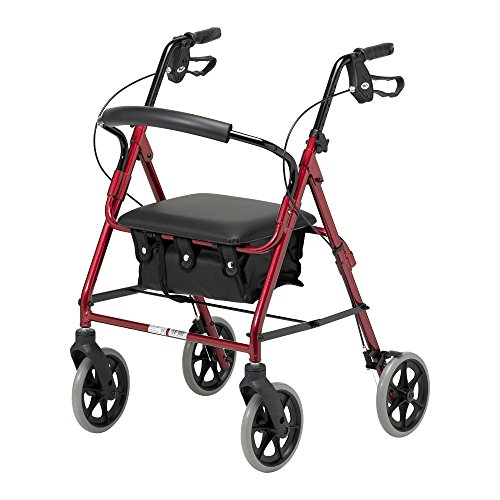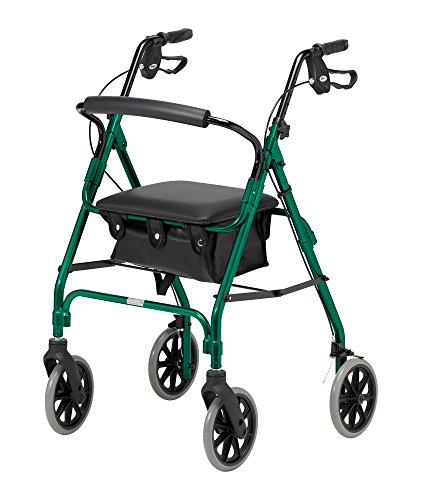See What Rollator Mobility Walker Tricks The Celebs Are Using
페이지 정보

본문
 Rollator Mobility Walker
Rollator Mobility Walkerrollators tri are a good option for those with a limited mobility who need stability when walking. They have big wheels, and a seat built into their frames.
The model comes with padded handles that create comfort and relieve pressure on the hands. It comes with adjustable handlebars that can be adjusted in height and intuitive loop locks that prevent the walker from moving even when you're seated or lying down.
Comfort
Whether someone has recently suffered an injury that affects their gait and balance, or recovering from knee, hip or other lower-limb surgeries or injuries, a rollator mobility walker can help. These walking aids offer stability and support, allowing users to walk more easily while keeping them active and connected to their family, friends and community.
These devices are available in a variety like a traditional walker that has no wheels that looks more plain than a walker that is rolling. The handles of walker typically are placed at a height that is most comfortable for the user, which makes them suitable for anyone who requires a stable support, but still wants to be able to move forward more easily than with a cane.
The wheels on a rolling walker allow it to be more flexible and easier to use than a standard walking device. The wheels are closer together, which means it is easy to steer and maneuver the device in tight spaces. Additionally, they can also be rotated to increase the speed of going up or down stairs. Many rollators come with a seat and crossbar to provide users with a place to rest when they need to.
rollator for tall people handles can be constructed from materials that vary in thickness and texture. Grips made of plastic can be difficult for people with arthritic hands Choose soft and smooth handles that are comfortable to hold. Consider whether the device has loop-lock brakes or lean-activated brakes to accommodate a variety of hand sizes.
Stability
A good rollator walker should have a wide and comfortable seating area for people to take an break from walking. It should have easy-to-operate brakes and ergonomic, soft grips. These grips should be padded and comfortable for people with wrist or hand issues. Some models include a padded support backrest. You should select an walker with a weight capacity that is sufficient for your needs and adjustable handles to fit your height.
A walker that has an locking mechanism is crucial for those who regularly travel or require transporting their walker inside and out of vehicles. It can help stop the walker from becoming accidentally opened while traveling, preventing injuries and other damages. Consider whether the walker is customizable to your needs by having interchangeable and removable components.
Researchers conducted a study to find out how the strategy for task-performance, and the device load affect the stability of the rollator. The study involved ten participants who completed six tasks using an instrumented rollator. The team measured the combined centre of pressure and the base of support that is known as the system Stability Margin (SM). They discovered that SM is reduced significantly when compared to straight line walking to other tasks. They also found out that leaning on the device can increase the force centre in the base support and can also increase or decrease stability. The authors conclude that the findings can be utilized to improve the rollator training. They suggest that greater focus should be given to activities that are not straight line walking and on the specific strategies to perform of each exercise that can aid or hinder stability.
Weight-bearing capacity
A rollator walker can be capable of supporting up to 300 pounds, or more depending on the model. Its sturdy frame with four wheels can aid in maintaining the balance and mobility of people particularly with chronic illnesses or aging. As opposed to standard walkers which require lifting to move forward, a rollator is able to be maneuvered with the user's weight, which can help to reduce hand fatigue.
Rollators have wheels that range from 6 to 10 inches wide. This allows them to be used indoors as well as outdoors on different surfaces. Certain models have a variety of height options for different users. Others fold up to make it easy to transport and store. Some even feature a seat that allows users to rest while walking.
Many walkers come with a range of accessories, like the walker basket, which can be used to store personal items or a tray for food items to be placed on while using the device. A wrist guard is provided to safeguard your hands from injury, as well as a walker's bag to carry other items. Certain walker frames can be converted to wheelchairs when the mobility requirements of a person change.
A bariatric rollator wheelchair is constructed with a strong frame and a wider seat to safely support larger people. It comes with adjustable height handles and a wide padded backrest, as well as locking hand brakes to provide the highest level of security and safety. The angled handlebars place the hands in a neutral, stress-free position. The convenient storage strap allows it to be easily tucked into the trunk of a car. The 8" wheels are equipped with anti-tip technology for added stability and maneuverability. The cushioned seat provides an ideal spot to rest when you're on the move.
Brakes
A rollator is different from a traditional walker. Instead of having all four legs touch the ground, a rollator comes with wheels that are controlled by hand brakes located below or incorporated into the handlebars. This design allows you to maneuver through tight spaces and make sharp turns left or right. However, the brakes may sometimes become loose or hard to use, which could be a safety risk for those who are aging and weak hands.
Many manufacturers provide the option of adding brakes that can also be locked to improve safety and stability. This feature is particularly beneficial for individuals who may have difficulties squeezing or applying pressure to the brakes because of a weak grip or other health conditions such as arthritis. There are some variations in the method by which locking brakes are set up, however most walkers use the same steps to ensure they are correctly adjusted.
Before you attempt to adjust the lock brakes it is advised to read the maintenance instructions included with your mobility aid for specific instructions. To begin, locate the adjuster screw for your brake or knob, which is typically situated near the handle grips. Tighten it by rotating clockwise. This is crucial because if the adjuster has not been tightened correctly, it will not be possible to remove the brake cable from its slack. After tightening the adjuster screw for brakes move on to the lower nut for the adjuster and tighten it with the same method. Once you've completed these adjustments, test your brakes by gently pressing the levers. If they do not then it is most likely that the locking mechanism is damaged.
Accessories
There are a number of accessories that can be used by a the rollator walker. These include cup holders and baskets. Some are ideal for carrying things while walking. Others, like the Mobility Phone Grip, clip onto the bars that are vertically attached to a wheelchair or walker and expand to hold the smartphone. The grips can also rotate and adjust to the perfect height to hold the device. A majority of these accessories are made to be light and simple to use, and ideal for people with arthritis.
The majority of walker and rolling walker manufacturers have different handle heights so you can pick the one that is best for your body type. It is also important to take into consideration the capacity of a rollator's weight because this will affect how well it works for you. While most rollators are designed to accommodate people up to 300 pounds, some manufacturers provide bariatric models that can handle up to 500 pounds.
When choosing a walker or rollator, you must take into consideration the type of brakes. The brakes that are pushed down work by placing downward pressure on the frame to stop forward motion. Loop brakes operate similarly, but require both hands to be employed and a bit more strength. Both kinds of brakes offer essential safety features, so it is crucial to select the one that is right for you.
 See a doctor, a physical therapist or an occupational therapist if you're unsure of which model of walker or rollercaster would be most suitable for you. They can give you suggestions on features that are most beneficial for your specific needs and can help to find a model that works with any other equipment you already have in your home or stored.
See a doctor, a physical therapist or an occupational therapist if you're unsure of which model of walker or rollercaster would be most suitable for you. They can give you suggestions on features that are most beneficial for your specific needs and can help to find a model that works with any other equipment you already have in your home or stored.- 이전글10 Things That Your Family Taught You About Ignition Key Replacement Cost 24.09.22
- 다음글15 Hot Trends Coming Soon About 3 Wheel Buggies 24.09.22
댓글목록
등록된 댓글이 없습니다.


